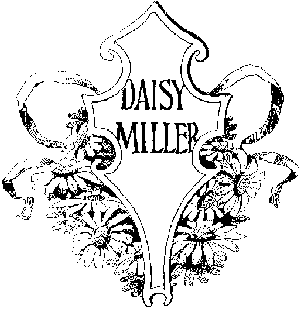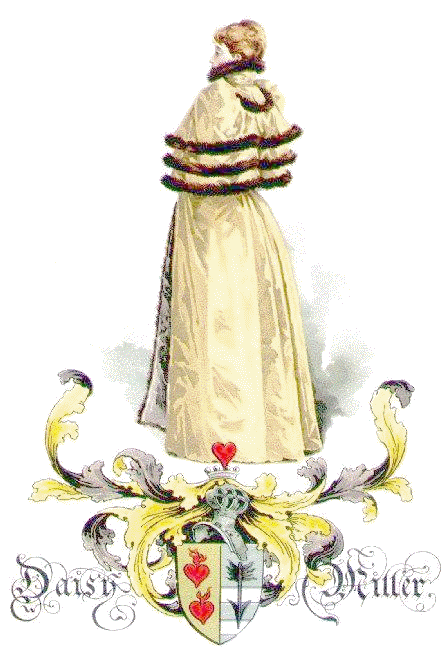

Preface
to the New York edition [1907]
It was in Rome during the autumn of 1877; a friend then living there but settled now in a South less weighted with appeals and memories happened to mention--which she might perfectly not have done--some simple and uninformed American lady of the previous winter, whose young daughter, a child of nature and of freedom, accompanying her from hotel to hotel, had 'picked up' by the wayside, with the best conscience in the world, a good-looking Roman, of vague identity, astonished at his luck, yet (so far as might be, by the pair) all innocently, all serenely exhibited and introduced: this at least till the occurrence of some small social check, some interrupting incident, of no great gravity or dignity, and which I forget I had never heard, save on this showing, of the amiable but not otherwise eminent ladies, who weren't in fact named, I think, and whose case had merely served to point a familiar moral; and it must have been just their want of salience that left a margin for the small pencil-mark inveterately signifying, in such connections, 'Dramatize, dramatize!' The result of my recognizing a few months later the sense of my pencil-mark was the short chronicle of Daisy Miller, which I indited in London the following spring and then addressed, with no conditions attached, as I remember, to the editor of a magazine that had its seat of publication at Philadelphia and had lately appeared to appreciate my contributions. That gentleman however (an historian of some repute) promptly returned me my missive, and with an absence of comment that struck me at the time as rather grim--as, given the circumstances, requiring indeed some explanation: till a friend to whom I appealed for light, giving him the thing to read, declared it could only have passed with the Philadelphian critic for 'an outrage on American girlhood'. This was verily a light, and of bewildering intensity; though I was presently to read into the matter a further helpful inference. To the fault of being outrageous this little composition added that of being essentially and pre-eminently a nouvelle; a signal example in fact of that type, foredoomed at the best, in more cases than not, to editorial disfavour. If accordingly I was afterwards to be cradled, almost blissfully, in the conception that Daisy at least, among my productions, might approach 'success', such success for example, on her eventual appearance, as the state of being promptly pirated in Boston--a sweet tribute I hadn't yet received and was never again to know--the irony of things yet claimed its rights, I couldn't but long continue to feel, in the circumstance that quite a special reprobation had waited on the first appearance in the world of the ultimately most prosperous child of my invention. So doubly discredited, at all events, this bantling met indulgence, with no great delay, in the eyes of my admirable friend the late Leslie Stephen and was published in two numbers of the Cornhill Magazine (1878).
It qualified itself in that publication and afterwards as 'a Study'; for reasons which I confess I fail to recapture unless they may have taken account simply of a certain flatness in my poor little heroine's literal denomination. Flatness indeed, one must have felt, was the very sum of her story; so that perhaps after all the attached epithet was meant but as a deprecation, addressed to the reader, of any great critical hope of stirring scenes. It provided for mere concentration, and on an object scant and superficially vulgar--from which, however, a sufficiently brooding tenderness might eventually extract a shy incongruous charm. I suppress at all events here the appended qualification--in view of the simple truth, which ought from the first to have been apparent to me, that my little exhibition is made to no degree whatever in critical but, quite inordinately and extravagantly, in poetical terms. It comes back to me that I was at a certain hour long afterwards to have reflected, in this connection, on the characteristic free play of the whirligig of time. It was in Italy again--in Venice and in the prized society of an interesting friend, now dead, with whom I happened to wait, on the Grand Canal, at the animated water-steps of one of the hotels. The considerable little terrace there was so disposed as to make a salient stage for certain demonstrations on the part of two young girls, children they, if ever, of nature and of freedom, whose use of those resources, in the general public eye, and under our own as we sat in the gondola, drew from the lips of a second companion, sociably afloat with us, the remark that there before us, with no sign absent, were a couple of attesting Daisy Millers. Then it was that, in my charming hostess's prompt protest, the whirligig, as I have called it, at once betrayed itself. 'How can you liken those creatures to a figure of which the only fault is touchingly to have transmuted so sorry a type and to have, by a poetic artifice, not only led our judgement of it astray, but made any judgement quite impossible?' With which this gentle lady and admirable critic turned on the author himself. 'You know you quite falsified, by the turn you gave it, the thing you had begun with having in mind, the thing you had had, to satiety, the chance of "observing": your pretty perversion of it, or your unprincipled mystification of our sense of it, does it really too much honour--in spite of which, none the less, as anything charming or touching always to that extent justifies itself, we after a fashion forgive and understand you. But why waste your romance? There are cases, too many, in which you've done it again; in which, provoked by a spirit of observation at first no doubt sufficiently sincere, and with the measured and felt truth fairly twitching your sleeve, you have yielded to your incurable prejudice in favour of grace--to whatever it is in you that makes so inordinately for form and prettiness and pathos; not to say sometimes for misplaced drolling. Is it that you've after all too much imagination? Those awful young women capering at the hotel-door, they are the real little Daisy Millers that were; whereas yours in the tale is such a one, more's the pity, as--for pitch of the ingenuous, for quality of the artless--couldn't possibly have been at all.' My answer to all which bristled of course with more professions than I can or need report here; the chief of them inevitably to the effect that my supposedly typical little figure was of course pure poetry, and had never been anything else; since this is what helpful imagination, in however slight a dose, ever directly makes for. As for the original grossness of readers, I dare say I added, that was another matter--but one which at any rate had then quite ceased to signify.
HENRY JAMES